
Royal Enfield 1898- UK
Humour of sorts has been aimed at motorcycle marques since time began. Much good natured, some less so. And of the world’s major players, Royal Enfield have been the butt of more jokes than most. Yet as Enfield fans tell us, few motorcycle brands remain in production over 100 years after their launch. Perhaps that’s stretching a point as the company was founded in the UK and is now Indian based, but a fact nonetheless.
For much of its UK existence the company traded as The Enfield Cycle Co Ltd and gained the brand name Royal Enfield, thanks to a one time tie up with the Royal Small Arms Factory of Enfield, Middlesex. The company logo of ‘Royal Enfield’ emblazoned over a large military gun is a reminder of this association and it’s nice to imagine the famous model name Bullet is thanks to this tie up.
Royal Enfield may have been the butt of more than its share of jokes, but they had many moments of which to be justly proud in racing and off-road sport. They were at times innovative, being among the first to use dry sump lubrication (1913 350/425cc V-twin) and the neutral finder found on many foot change models is for my money a top idea.
By the late 1880s George Townsend and Co, Hunt End, Nr Redditch, Worcestershire had graduated to building complete cycles under the Ecossais brand. During 1890 they were in financial difficulties and needed further investment. Sadly George and Foster Townsend were at odds with the ‘new money’ and left. Albert Eadie, former cycle department manager of H Perrey and Co, Birmingham, became the new MD while Robert Smith – assistant works manager at Rudge, Coventry – was appointed works manager of the restructured company, now named The Eadie Manufacturing Co. By 1892 the cycles were known as ‘The Enfield.’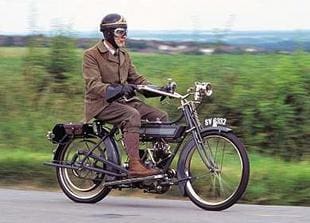
A new company, named The Enfield Manufacturing Co, was established and registered to market complete cycles built by The Eadie Manufacturing Co and in 1896 The New Enfield Cycle Co was formed and registered to take over cycle production from The Eadie Manufacturing Co. Within a year ‘New’ was dropped leaving The Enfield Cycle Co Ltd which is familiar to us motorcyclists. The Eadie Co moved to Lodge Road, Redditch, while The Enfield Co Ltd remained at Hunt End.
Circa 1898-99 Enfield began experimenting with De Dion Bouton engines powering tricycles and quadricycles. By 1900 these vehicles made appearances in sporting events including The Thousand Miles Trial, crewed by EM Iliffe as driver and Enfield motor department manager Walter Grew as crew and spanner man.
Widening horizons further, the company motorised one of their sturdy cycles with a Belgian made Minerva kit, employing direct drive to the rear wheel by rawhide belt. With designs by French engineer Jules Gobiet, The Enfield Cycle Company came up with their own machines, comprising a 11⁄2hp four-stroke engine clamped to the cycle’s steering head with drive to the rear wheel by crossed over rawhide belt. The theory behind this set-up was that more of the belt was wrapped around the drive pulley giving more surface area contact, to help minimise slip. To drive the cycle forwards, the engine had to run backwards.
While the drive concept may seem bizarre, the neat little engine employed a surface carburettor and phosphor bronze alloy conrod to negate the need for little and big end bushes. The idea was used by some Japanese makers during the Sixties with considerable success for little end applications. A number of variants of the 11⁄2hp Royal Enfield were made with differing engine positions tried. Significantly, one variant employed a crankcase oil sump, a sign of Enfield designs to come.
Motorcycle sales were, in common with rivals, modest and The Enfield Cycle Co turned its attention to the seemingly more lucrative motor car business and dropped motorcycle production c1904. With an eye on business expansion, The Enfield Autocar Company was established in 1906 but was soon struggling, sliding into liquidation a year later. Assets were bought by Alldays and Onions of Birmingham. They continued with the business making various models, some identical to Alldays and Onions products, marketed as the Enfield or Enfield-Alldays. A new factory at Sparbrook was built in 1909 and the car business continued until 1915.
The Enfield Cycle Co Ltd licked their wounds and returned to concentrate on the manufacture of cycle and motorcycle components from their premises at Hunt End. A new factory at Hewell Road, Redditch was established and soon became their sole premises. BSA acquired the Eadie Manufacturing Co from Enfield, Albert Eadie moved too, resigning his position on the Enfield Cycle Co Ltd board to leave Mr RW Smith at the helm.
By 1910 motorcycling was clearly here to stay and sales were climbing. Rather like BSA, who had hesitantly dipped a toe into motorcycling c1904-05, Royal Enfield rekindled their interest too. Unveiling a neat but fragile looking 21⁄4hp Motosacocche engined V-twin Royal-Enfield at the 1910 Motorcycle and Cycle Show, the company publicly announced their return to motorcycle manufacture. A larger 23⁄4hp (350cc) version soon appeared, often offered with two-speed gearing.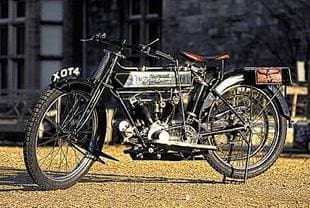
Keen to promote their ‘new’ motorcycles Enfield established a competition department and tempted the legendary Bert (HV) Colver from Matchless. Bert, a renowned cycle track and later Brooklands expert, gave Enfield wins and places at Brooklands and other speed events. But despite this success he couldn’t have been that happy at Redditch, or perhaps he just missed London, as by 1914 he was back at Plumstead with Matchless.
Isle of Man forays kicked off with a fifth in the 1911 Junior TT, the first ever Junior race and the first year round the mountain course. On the roadster front came the 6hp (initially 770cc JAP) V-twin and the Enfield patent Cush hub which was to gain world renown.
Developing his earlier concepts, Mr WH Guillon designed the 3hp (425cc) inlet over side-exhaust valve V-twin. In many respects the model was an advanced machine, especially its lubrication system. An automatic oil pump fed oil under pressure to the big end via a hollow crankpin and then scavenged it for return to the cylindrical oil tank mounted on the saddle down tube. A pioneering example of dry sump lubrication.
Sleeved down to 350cc, it performed well at Brooklands piloted by Bert Colver and of nine entries, eight finished in the 1914 Junior TT. Tragically FJ Walker crossed the line third unaware his race was over and fatally crashed into a temporary barrier erected across the course to keep the crowds back after the finish. It’s claimed this incident led to the use of the chequered flag at the end of races worldwide.
During 1914 the Enfield factory began entering a two-stroke motorcycle at a few hill climbs, including Style Cop Hill. Its design initially incorporated slide valve port control but production costs dictated the use of cheaper conventional 225cc design which in two-speed form proved a huge success in the economy motorcycle marketplace. Involved in many aspects of military supply including cycles for the war effort duringWWI the Redditch factory still had enough capacity to build a moderate number of 770cc V-twin outfits armed with Vickers machine guns for the allied war effort, along with solo versions for the Russian forces.
Rather than launch new untried models at the end of WWI, as some rival firms did, Enfield’s 1919 programme comprised more of the same. At the budget end was the two-speed 23⁄4hp two-stroke, while the big V-twin was dusted down and grew to 8hp with a full 1000cc V-twin JAP engine and the 3hp V-twin was aimed at the sporting rider, although this model was dropped within a year. Redditch reasoning behind this unadventurous programme was sound – they’d spent the period of hostility working for the war effort and, without the huge resources of manpower and finance the really big players enjoyed, they relaunched with proven products, giving themselves breathing space to design and test new models.
Unveiled for the 1921 season, a new 976cc V-twin had an Enfield-designed but Vickers-built engine. Then, for 1924, Redditch launched an attractive brace of EO Pardoe-designed 350 singles, offered in both ohv and side-valve trim. At the same time, the two-stroke was updated and offered with the option of an open frame aimed at lady riders. Expanding the range for the following season, Enfield added sports versions of both the big V-twin and the two-stroke. Sturmey Archer gearboxes became common to all models except the lightweights; the V-twin engine was redesigned and put into production at the Redditch factory and a 225cc side-valve lightweight joined the catalogue.
Although Royal Enfield had performed satisfactorily in reliability trials since before WWI, the launch and development of the 350cc singles raised trials success onto a new level. Suddenly they became a marque to beat in the competition world; the ohv version was an attractive, cracking all rounder.
Having last raced at the IoM TT in 1914, Royal Enfield quietly returned in 1925 with South African CH Young finishing seventh in the Junior and G Reynard 17th. More places followed in Lightweight and Junior races in 1926 and the following year the Redditch factory scooped the Junior race team prize. After Cecil (CS) Barrow’s second in the 1928 Lightweight and more worthy places in the 250 and 350 races, Royal Enfield began to lose interest in racing – they had been racing stripped roadsters against factory-built works racers which made their results all the more impressive. As a swansong and after riding other marques, Barrow finished eighth in his last TT race, the 1935 Senior, on a race-prepared Royal Enfield roadster.
Back to roadsters and in 1927 Enfield unveiled their first 500 (488cc) single, in effect half a V-twin. As the Twenties drew to a close old favourites were redesigned and uprated gaining saddle tanks; first the 225cc side-valve for 1928, then other models followed. Last to be given a makeover were the 488cc side-valve and some two-stroke models. Despite their best efforts with a wide range of keenly priced, attractive models, the Enfield Cycle Co Ltd showed an end of term loss for the year 1930/31 – the first time since late Victorian times.
Hitting back against the depression, Royal Enfield unveiled the rugged 570cc side-valve for 1931, updated existing models and, just as the London Show was being readied for the late autumn crowds, announced a four-valve 488cc ohv single, the JF. At times, the ambitious claimed 110mph from the four-valve 500cc Enfield – perhaps possible when stripped and prepared for racing as Cecil Barrow’s 1935 TT entry but less likely in full road trim with electric lighting and charging kit fitted. For the 1930 model, code letters replaced the familiar numbers.
Subtle year-on-year changes continued with pushrod tunnels integral with the barrels for the first time for 1932, first seen on the four-valve model LF. Its sports specification included a foot change four-speed gearbox and upswept exhaust pipes. In complete contrast, the fully enclosed 148cc two-stroke Cycar with pressed steel frame and front fork was announced too – a tidy little runabout for just 21 guineas (£22.05). If models were changing with the times, so to was life behind the scenes at Redditch. Joint founder Albert Eadie died in 1931, followed two years later by his founding partner RW Smith. Mr Smith had three sons – one, Major FW Smith, moved from assistant managing director to MD on his father’s death.
For the 1933 season the name Bullet was given to sporting ohv singles in three capacities of 248, 346 and 488cc aimed at the enthusiast rider and in January 1933 – with lengthened stroke – the big V-twin was optionally offered for the first time with its capacity upped to 1140cc, initially for export markets only. The model Z 148cc two-stroke Cycar was joined by the Model X, with similar but upright engine.
A year later, still seeing further sales potential in the ultra lightweight sector thanks to the Snowden tax concession, the Redditch factory unveiled one of the neatest 150 (148cc) ohv singles built, the Model T. With fully enclosed valve gear, sloping engine, lively performance and miserly fuel consumption, it was a near-perfect motorcycle in miniature.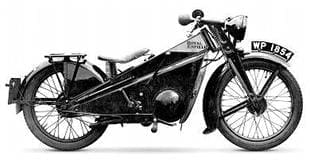
As the Thirties rolled by, Enfield continued to tweak their model range – briefly, a three-valve 500cc Bullet appeared for the 1935 season. The earlier four-valve head had displayed a tendency to crack but after a year the three-valve option was dropped in favour of a revised four-valve design, the JF. Early in 1936 two ‘pukka’ over-the-counter competition models were offered in 346 and 499cc forms, based on the two-valve model J.
In addition to irregular support of the IoM TT with race-prepared roadsters, Enfield had since 1910 been a keen supporter of off-road competition. Their household names once included Freddie Thacker and Fred Bicknell and when the J Competition models were announced, Jack Brooker, Len Holdsworth and Charlie Rogers were the core of their renowned trials team. Charlie Rogers faithfully served Redditch for many years after his riding career including preparing competition machines and running teams. For some years, Charlie also oversaw the factory service department.
By the late Thirties the 1140cc K and KX V-twins were available on the home market and – although often overlooked – the reliable two-stroke 225cc Model A, which had served the utility market so well in the Twenties, continued with more of the same, albeit with regular updates, during the Thirties. Equally faithful had been the side-valve single Model B, marketed in 225cc form in 1930 and, after a break of two years, appeared updated as a 248cc model in 1933. After becoming the upright engine Model D in 1939, it was bought in small numbers (approx 2150 machines) by the military as a training motorcycle.
Although not providing machines in the volume of BSA, Royal Enfield served the allies well. Models supplied included over 17,000 steady, reliable side-valve 346cc Model WD/Cs and over 24,000 ohv 346cc Model WD/CO – for many DRs the machine to have and rightly popular with military fans today.
Another aspect of their work for the allies saw Redditch involved with one of the more bizarre, unusual or adventurous – depending on your viewpoint – WWII projects. The tiny 126cc two-stroke WD/RE was based on proven DKW design and tales abound of how the designs or complete machines (or both) were smuggled via Holland to the UK for evaluation.
In effect, the WD/RE was developed as a cheap, light disposable motorcycle for the airborne forces which were to become the British airborne arm in 1942. Sadly, the smuggling tales are myths – cold reality states in the run up to WWII, DKW were no longer supplying the popular RT-100 to their Dutch agent Stokvis and Zonen, who were also Royal Enfield suppliers. S and V encouraged Royal Enfield to develop the model during 1939 for inclusion in the planned 1940 civilian range. The War Office evaluated the model. Recommendations included a Villiers carburettor (noted by V-prefix to engine number) plus folding handlebars and footrests, enabling its stowage in a protective tubular parachute cradle.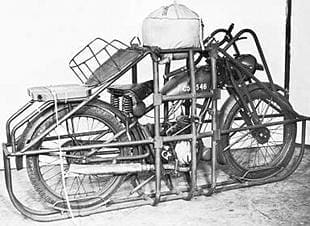
Well in excess of 5000 WD/REs – with hindsight, nicknamed the Flying Flea – were delivered to the military. The thought of dropping these diminutive machines from the bomb racks of a Lancaster bomber or Douglas Dakotas seems unkind, but the advance assault parties needed transport. Many more were installed in troop-carrying gliders minus cage and strapped to the inside of the fuselage. Coming late in WWII, not all of the last contract of Flying Fleas was taken up – these along with military surplus models were converted for civilian sales after the war ended.
Returning to peacetime, Royal Enfield initially offered ex-WD 350cc side-valve and ohv models, many overhauled at their Bradford-on-Avon depot. Civilian manufacture restarted with the Flying Flea, and updates of the pre-WWII 348cc Model G and 499cc Model J – both with telescopic front fork – while the two-stroke lightweight used pressed steel blade girder style fork, with rubber suspension.
Behind the scenes, the Redditch development team was busy, the first fruits appearing at the February 1948 Colmore Cup Trial. With examples ridden by Charlie Rogers, Len Holdsworth and Jack Plowright, the new 348cc trials prototypes sported full swinging arm suspension, revised engine with alloy cylinder head and a bolt up gearbox. The new post-WWII roadster Bullets were to soon follow. Successes, including winning both the International Trophy and Silver Vase at the year’s ISDT were followed by further victories over the next few seasons.
By the London Show in November 1948, the Redditch factory was on song as Enfield launched their new Bullet roadsters and their first production vertical twin. Of 500cc, it featured separate cylinder barrels and heads, forged one-piece crankshaft, two camshafts, coil ignition and swinging arm rear suspension.
Two years later, Redditch rejoined the 250cc marketplace with the S51, in effect an update of the sound pre-WWII model but with telescopic front fork in place of girders.
More models were unveiled at the 1952 London Show, again with an eye on the next season. A new 148cc three-speed two-stroke single named the Ensign, a 500cc Bullet and the Meteor 700cc (692cc) ohv twin which was renamed the Super Meteor for 1956. All models had a full swinging arm frame except the 125cc RE2, 346cc Model G and 499cc Model J.
Cashing in on the competition success, especially that of Johnny Brittain whose wins included the 1952 SSDT and Welsh Two-Day Trial and the British Experts in 1952 and 1953, sporting models were offered in early 1954 in 350 and 500cc capacities for trials, scrambles or racing. An all-new ohv 250, the Clipper appeared and for the first time the famous alloy ‘casquette’ fork top enclosure.
Model revisions continued through the Fifties, including an updated frame design for the Bullet and Meteor, electrical revisions and the launch in late 1956 of the 17in wheel 250cc ohv Crusader for the 1957 season. Rather adventurous styling was considered when Enfield and a section of the press were involved in a futuristic fairing design – prototypes were named the ‘Dreamliner’. Conservative thoughts led Redditch to moderate the design and market it as the Airflow – an advanced motorcycle factory developed concept for the times.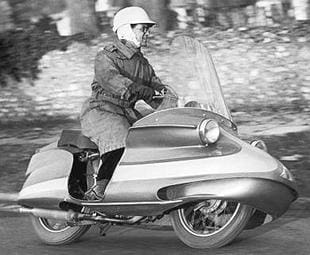
One of the smartest production trials models of the Fifties rolled out of the Redditch factory for the first time in late 1958, the 350cc Works Replica – now highly sought after.
Alongside this appeared a sports version of the Super Meteor named the Constellation. For the full adrenalin rush, try the early GP carburettor model which the period weeklies clocked at 116mph. Next the 500 twin was revamped to give the Meteor Minor. The five-speed 250cc Crusader Super-5 was unveiled for the 1962 season. In the quest for even more power, at the end of 1962 the 52bhp 736cc Interceptor Twin appeared. With a top speed of well in excess of 100mph, the factory claimed it would cruise forever at 85-90mph. It did.
Behind the scenes company control was shifting. Major Frank Smith, who’d joined Royal Enfield before WWI, retired as managing director in 1960, although he remained chairman. He died two years later. Also in 1962, the company merged with E&HP Smith Ltd, a holding company of many Midlands engineering concerns. As a result, by January 1963 Leo Davenport (winner of 1932 Lightweight IoM TT – 246cc New Imperial) was appointed joint managing director along with Major Vic Mountford, who’d joined Royal Enfield in the late Twenties, and who died in 1965.
In contrast to rival factories – who trimmed their model range in a desperate bid for survival – Royal Enfield added to the catalogue during the early to mid-Sixties; in the 250cc class at one time, nine models were listed. Stars included the bright red five-speed cafe racer Continental GT – great fun but often temperamental. Others included the five-speed Alpha/Enfield 250cc production racer, with some development work by Herman Meier, and the Villiers 4T engined Turbo Twin.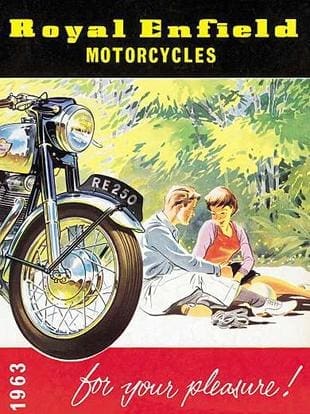
Despite these valiant efforts and the services of Geoff Duke in an advisory capacity, Royal Enfield motorcycle production was in trouble. Their racer efforts ended in autumn 1965, after Gordon Keith had hit 125mph at the TT on a 250.
The plant and equipment from the Redditch factory was sold during 1967. Manufacture of the Interceptor continued at Bradford on Avon, as Enfield Precision – under Norton Villiers control – from 1968. The last batch of engines went in 1970 to Rickman, for the superb handling Rickman Interceptor.
That should have been the end of the story but as we all know it isn’t.
In the mid-Fifties – under Indian government guidance – the Madras Motor Co began importing Royal Enfield kits (mostly Bullets) for assembly in India. As time passed, they began making parts for these machines in India and gradually increased the portion of each new motorcycle they made until finally the whole was made and built in India.
After British Royal Enfield production ended, the Madras concern continued building Bullets. For some time focus centred on the 346cc Enfield Bullet – some were imported to Europe and the UK, although early supply was erratic.
Old fashioned, slow and needing the type of regular maintenance intervals modern owners wouldn’t tolerate, so the period modern press claimed… But for a portion of the buying public, the press was wrong and many were happy with this dated ‘blast from the past’. It was understandable the transport starved Indian market would tolerate erratic supply, but UK buyers were prepared to wait too; for a motorcycle that was traditional, modestly priced and different.
In response, the Madras plant upped their game, introducing better brakes, 12-volt electrics and a 500cc model. Further development has included electric start, more models, gearbox redesign, the permitted adoption of the full Royal Enfield name – rather than just Enfield – and much more. Good for Enfield and their owners but out of the remit of our 25 year ‘rule’.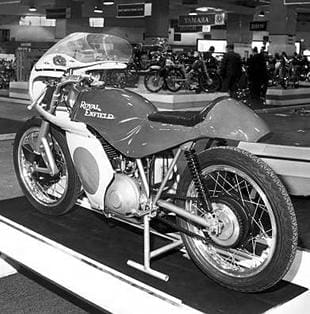
Earlier 350cc Bullets occasionally appear on the UK market as ‘collectors’ items’ while the new models give marque enthusiasts the chance to sample a brand new classic, often for less money than the cost of restoring a period model. However, don’t expect the 350/500 Royal Enfield Bullet to be a slavish replica of a 1956-60 model. It isn’t; instead, it’s a development of the Royal Enfield single cylinder concept.
Certain quarters do pour scorn on the products of the Redditch and/or Madras factories. Largely this scorn is misplaced. Royal Enfield built a range of sound models from 125cc lightweights to large quick twins, which ably perform all the roles we expect from our classics, regardless of whether we’re a daily go-to-work rider or simply pursue our motorcycling in the summer months on club runs. And, thanks to an excellent spares back-up by a renowned specialist dealer, most post WWII Enfields don’t ever need to be off the road for too long.



